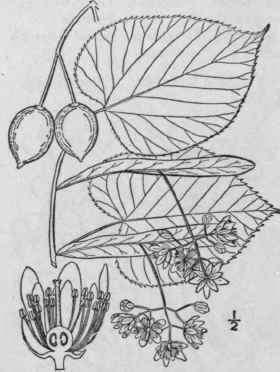Family 84. Tiliāceae Juss. Gen. 289. 1789
Description
This section is from the book "An Illustrated Flora Of The Northern United States, Canada And The British Possessions Vol2", by Nathaniel Lord Britton, Addison Brown. Also available from Amazon: An Illustrated Flora of the Northern United States, Canada and the British Possessions. 3 Volume Set..
Family 84. Tiliāceae Juss. Gen. 289. 1789
Trees, shrubs or rarely herbs, with fibrous bark, alternate (rarely opposite) simple leaves, mostly small and deciduous stipules, and axillary or terminal generally cymose or paniculate flowers. Sepals 5, rarely 3-4, valvate, deciduous. Petals of the same number, or fewer, or none, alternate with the sepals, mostly imbricated in the bud. Stamens 00, mostly 5-10-adelphous; anthers 2-celled. Ovary 1, sessile, 2-10-celled; style entire or lobed; ovules anatropous. Fruit 1-10-celled, drupaceous or baccate. Embryo straight, rarely curved; cotylendons ovate or orbicular; endosperm fleshy, rarely wanting.
About 35 genera and 275 species, widely distributed in warm and tropical regions, a few in the temperate zones.
1. TÍLIA [Tourn.] L. Sp. Pl. 514. 1753.
Trees, with serrate cordate mainly inequilateral leaves, and axillary or terminal, cymose white or yellowish perfect flowers, the peduncles subtended by and partly adnate to broad membranous bracts. Sepals 5. Petals 5, spatulate, often with small scales at the base. Stamens 00; filaments cohering with the petal-scales or with each other in 5 sets. Ovary 5-celled; cells 2-ovuled; style simple; stigma 5-toothed. Fruit dry, drupaceous, globose or ovoid, inde-hiscent, 1-2-seeded. Seeds ascending; endosperm hard; cotyledons broad, 5-lobed, corrugated. [The ancient Latin name.]
About 20 species, natives of the north temperate zone, 1 in the mountains of Mexico. Type species: Tilia europača L.
Leaves smooth or very nearly so, sometimes glaucous. | 1. | T. americana. |
Leaves mostly densely hairy beneath, not glaucous. | ||
Leaves brown-hairy or rusty-hairy beneath. | 2. | T. pubescens. |
Leaves white, grey or silvery beneath. | ||
Bracts mostly abruptly narrowed at the base, sessile or nearly so. | 3. | T. heterophylla. |
Bracts mostly attenuate at the base, distinctly stalked. | 4. | T. Michauxii. |
1. Tilia Americāna L. Bass-Wood. American Linden. White-Wood
Fig. 2843
Tilia emericana L. Sp. Pl. 514. 1753.
T. glabra Vent. Mem. Acad. Paris 4: 9. pl. 2. 1802.
Tilia canadensis Michx. Fl. Bor. Am. 2: 306. 1803.
A large forest tree, 6o°-125° high, with spreading branches; trunk 2°-$° in diameter. Leaves obliquely ovate, cordate or sometimes truncate at the base, 2-5' wide, coriaceous, glabrous on both sides, or with some pubescence on the veins of the lower surface, sharply serrate with glandular teeth, abruptly acuminate or acute; petioles 1'-2' long; floral bract 2-4' long, often narrowed at the base, strongly veined; cymes drooping, 6-20-flowered; flowers 5"-7" broad, fragrant; petals yellowish-white, crenate, slightly longer than the pubescent sepals; scales similar to the petals, but smaller; fruit globose-ovoid, 4"-$" in diameter.
In rich woods and along river-bottoms, New Brunswick to Georgia, especially along the mountains, west to Manitoba, Nebraska and Texas. Wood soft, weak, light brown or reddish; weight per cubic foot 28 lbs. Used for cabinet work and for paper pulp. Bast-, lin-, lime-, bee-, black-lime- or monkey-nut-tree. White-lind. Southern linn. Yellow bass-wood. Wickup. Daddy-nuts. Spoon-wood. Whistle-wood. May-June.

Continue to:


